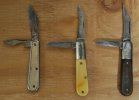1956 to 1988 Manufacture. I
think the model number is 240.
(1988 to the 2004 Imperial Schrade bankuptcy were stamped "Imperial Ireland". The Imperial plant in RI burned down in '88. They moved production to a knife factory in Ireland they bought.)
Blades are 1095 carbon steel. Imperial-Schrade's 1095 has an excellet heat treat, by the way.
Looks like Grandpa used that knife quite a bit.

The blades are about 3/4 maybe a little more full.

Honestly, I don't see anything that needs "restored".
It has shell construction, the "bolsters" and "covers" are a single piece of tin clipped on the knife at the ends. (If you look, you'll see the folded tabs on the bolster ends.)
The blades have a little patina. There's nothing wrong with that. As a matter of fact, a patina helps keep rust at bay.
At most I'd wash it out good with hot soapy water and a toothbrush, then blow the water out with canned air or WD-40, oil the joints, put a light coat of oil on the blades, hit the edges with a dry strop, and it's ready to go.
I like DAWN dish soap best for washing out a knife.
EDIT: Never hit it with a sharpening stone until
after it is stropped. If after stropping there is a reflection on the edge apex you can hit it with the stone. At least 90 ~ 95% of the time a dry leather strop will restore the blade to a working edge.
Stropping as opposed to a sharpening stone extends the "life" of the blade considerably.
These were an inexpensive knife when new; even at the end they were only a couple dollars. Some would call them a "boy's knife" because a kid could get one with his paper route money or from the bottle deposits he (or she) got from unbroken soda bottles found along the road. Also, they wouldn't be out a lot of money when they lost it.
A lot of savey and practical adults carried a "boy's knife" by the way. While they used a cheaper means of manufacture (shell constuction as opposed to real bolsters and seperate covers, in the case of this Barlow) they have the same blades with the same heat treat as the more expensive knives. They are good working knives. "Inexpensive" did/does not necessarally mean junk/garbage.
My Great Grandfather (1892 -1973) carried one of these Barlows. I believe his is in his pocket, now. (Family tradition is the favorite pocket knife/knives goes with you.)
Anyway, here's mine. 1956-1988 Prov. RI on left, 1988-2004 Ireland on the right.
View attachment 1647412
Note that Imperial-Schrade made this knife prior to 1956. The earlier knives have a different design tang stamp. I want to say the shell construction started in the 1930's.













